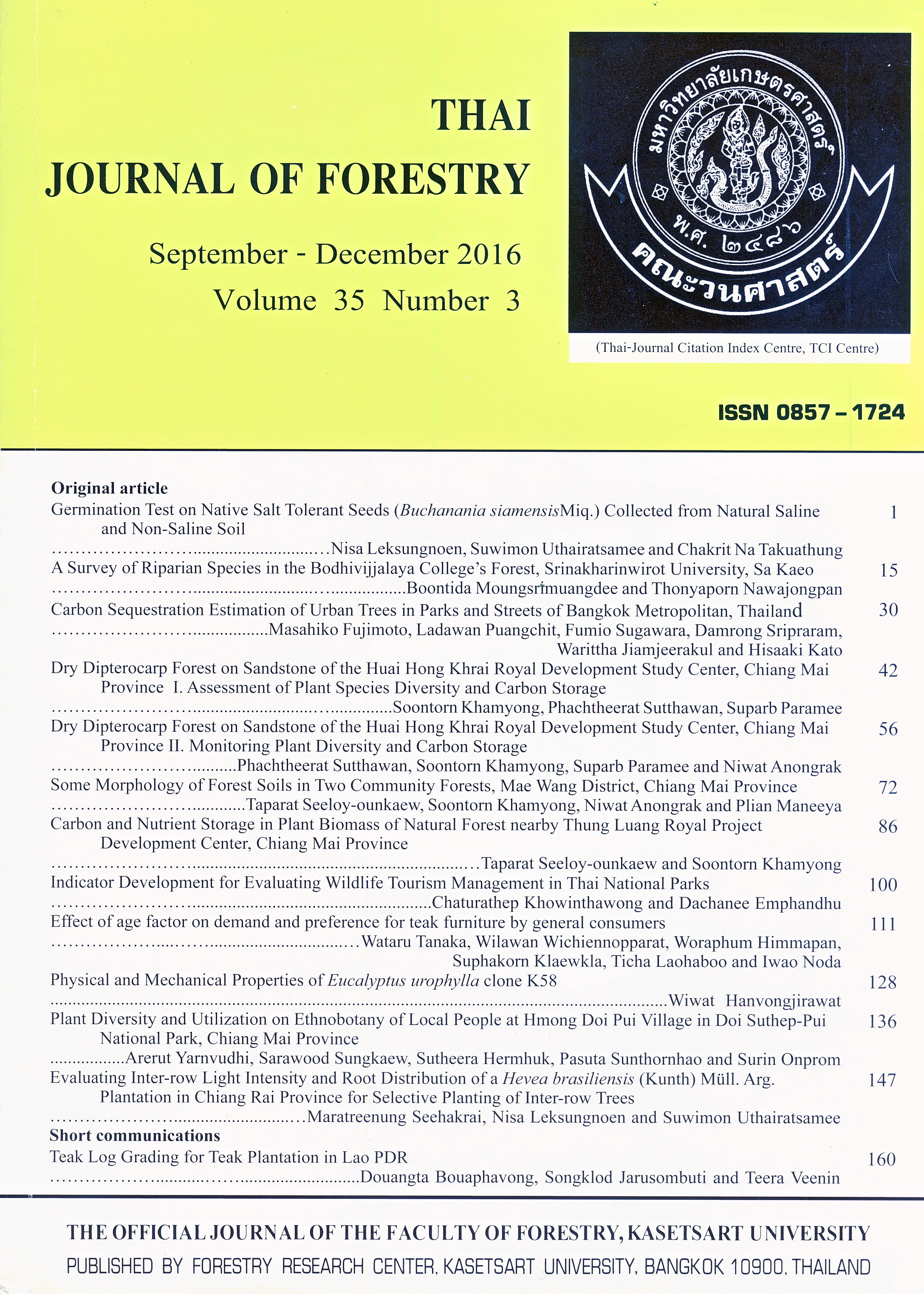Indicator Development for Evaluating Wildlife Tourism Management in Thai National Parks
Main Article Content
Abstract
The growth of wildlife tourism in Thai national parks has been well recognized and accompanied by concerns regarding its sustainability. This research developed indicators and evaluated the success of wildlife tourism management in three Thai National Parks: Khao Yai, Kuiburi, and Doi Inthanon. To develop the indicators, this study relied on literature reviews followed by a questionnaire survey to four target groups: park personnel, tourists, tour guides, and local leaders, and finished with an expert evaluation using the Delphi technique. The target groups ranked the importance of each indicator within a 5-point Likert scale from very low importance (0) to very high importance (5). A mean score of 3.41 or higher for an item was used as a cutoff for indicator selection from the results of the questionnaires and 4.20 or higher from the experts. The evaluation of wildlife tourism management using these indicators on each park was undertaken by the researcher, the national park superintendent, and a representative of NGOs working in the park. The study results revealed that there were 22 indicators in three groups: wildlife resources, tourism and visitor management, and institutional and managerial resources. The evaluation results of wildlife tourism management at Khao Yai, Kuiburi, and Doi Inthanon were rated as good management with scores of 1.94, 1.91 and 1.98 respectively, from a score range of 0 (need strong improvement in management) to 3 (very good management). For Khao Yai National Park, the least successful item was the interpretation program for tourist education and awareness raised (0.67), in Kuiburi and Doi Inthanon, it was the training of park personnel and nature guides on skill and knowledge in wildlife tourism (0.33 and 1.33, respectively).
Downloads
Article Details
ข้าพเจ้าและผู้เขียนร่วม (ถ้ามี) ขอรับรองว่า ต้นฉบับที่เสนอมานี้ยังไม่เคยได้รับการตีพิมพ์และไม่ได้อยู่ในระหว่างกระบวนการพิจารณาตีพิมพ์ลงในวารสารหรือสิ่งตีพิมพ์อื่นใด ข้าพเจ้าและผู้เขียนร่วม (ถ้ามี) ยอมรับหลักเกณฑ์และเงื่อนไขการพิจารณาต้นฉบับ ทั้งยินยอมให้กองบรรณาธิการมีสิทธิ์พิจารณาและตรวจแก้ต้นฉบับได้ตามที่เห็นสมควร พร้อมนี้ขอมอบลิขสิทธิ์ผลงานที่ได้รับการตีพิมพ์ให้แก่วารสารวนศาสตร์ คณะวนศาสตร์ มหาวิทยาลัยเกษตรศาสตร์ กรณีมีการฟ้องร้องเรื่องการละเมิดลิขสิทธิ์เกี่ยวกับภาพ กราฟ ข้อความส่วนใดส่วนหนึ่ง หรือ ข้อคิดเห็นที่ปรากฏในผลงาน ให้เป็นความรับผิดชอบของข้าพเจ้าและผู้เขียนร่วม (ถ้ามี) แต่เพียงฝ่ายเดียว และหากข้าพเจ้าและผู้เขียนร่วม (ถ้ามี) ประสงค์ถอนบทความในระหว่างกระบวนการพิจารณาของทางวารสาร ข้าพเจ้าและผู้เขียนร่วม (ถ้ามี) ยินดีรับผิดชอบค่าใช้จ่ายทั้งหมดที่เกิดขึ้นในกระบวนการพิจารณาบทความนั้น”
References
Department of National Parks, Wildlife and Plant Conservation. 2016. Visitor statistics in national parks. Available source: http://www.dnp.go.th/nprd/develop/stat_tourist.php, April 18, 2016.
Eagles, P.F.J. 1993. Park legislation in Canada, pp. 57-74. In P. Dearden, and R. Rollins (eds.). Parks and Protected Areas in Canada: Planning and Management. Oxford University Press, Don Mills, Ontario, Canada.
Eagles, P.F.J., S.F. McCool, and C.D. Haynes. 2002. Sustainable Tourism in Protected Areas. IUCN, Gland.
Emphandhu, D. 2003. Tourism management in national parks, pp. 1-50. In Training course for National Park Superintendents on National Park Concepts. Department of National Parks, wildlife and Plant Conservation, Bangkok, Thailand. (in Thai)
Emphandhu, D. 2009. Unit 4: Resource management for tourism in forest area, pp. 4-1 to 4-67. In D. Wechakit (eds.). Compiling Reading Materials in Subject of Resource Management for Forestry Unit 1-5. Graduate study, Agriculture Program in Agricultural Extension and Development, Sukhothai Thammathirat University, Thailand. (in Thai)
Emphandhu, D. and U. Poolpiphat. 2006. Strategic policy options for enhancing national park and local community linkage in tourism management of Thai national parks. Kasetsart Journal of Social Sciences 27 (2): 347-362.
Hawthorn, D., M. Kirik, and P.F.J. Eagles. 2000. Evaluating management effectiveness of parks and park systems: A proposed methodology, pp. 32. In Fourth International Conference of Science and the Management of Protected Areas. University of Waterloo, Waterloo, Ontario, Canada.
Higginbottom, K. 2004. Wildlife Tourism: An Introduction, pp. 1-14. In K. Higginbottom (eds.). Wildlife Tourism Impacts, Management and Planning. Common Ground Publishing Pty Ltd, Australia.
Jantowat, H., N.T. Phongkhieo, and S. Kaitpraneet. 2011. Responses toward regulations and recreational user management measures of visitors to Doi Inthanon National Park, Chiang Mai Province. Thai J. For. 30 (2): 39-47.
Moscardo, G., B. Wood and T. Greenwood. 2001. Understanding visitor perspectives on wildlife tourism, pp. 11. In Wildlife Tourism Challenges, Opportunities and Managing the Future. CRC for Sustainable Tourism Pty Ltd., Gold Coast, Queensland, Australia.
Nuthong, T. 2009. Unit 5 Resource management for wildlife conservation, pp. 5-1 to 5-73. In D. Wechakit (eds.). Compiling Reading Materials in Subject of Resource Management for Forestry Unit 1-5. Graduate study, Agriculture Program in Agricultural Extension and Development, Sukhothai Thammathirat University, Thailand. (in Thai)
Paisarn, N. and D. Emphandhu. 2008. Visitors response behaviors to warning signs in Phu Kradueng National Park, Loei Province. Thai J. For. 27 (2): 48-57. (in Thai)
Valentine, P. and A. Birtles. 2004. Wildlife watching, pp. 15-34. In K. Higginbottom (eds.). Wildlife Tourism Impacts, Management and Planning, Common Ground Publishing Pty Ltd, Australia.
World Tourism Organization. 1996. What Tourism Managers Need to Know: A Practical Guide to the Development and Use of Indicators of Sustainable Tourism. Madrid, Spain.
World Tourism Organization. 2004. Indicators for Sustainable Development for Tourism Destination: A Guidebook. Madrid, Spain. 507 pp.
Yamane, T. 1973.Statistics: An Introductory Analysis. 3rd ed., Harper and Row, New York, NY, USA.


